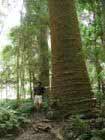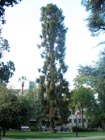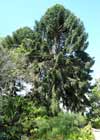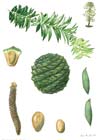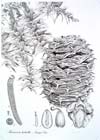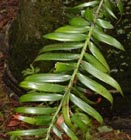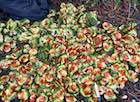Conservation Status

Araucaria bidwillii
Hook. 1843
Common names
Currently known as bunya pine, or simply bunya. Early settlers in Australia recorded many forms of the name used by indigenous peoples, including Banza-tunza, Banua-tunya, boonya, bunyi, bahnua, bon-yi, banya bunya, bunnia, bunya-bunya, and bonyi-bonyi. The superficial similarity of these names suggests that native peoples knew it by much the same name throughout its range, with the variants attributable to variant phonetic spellings. Similar variety applies to the native name for the edible nut, yenggee or jenggi (Huth 2002).
Taxonomic notes
Synonymy:
- Columbea bidwillii (Hook.) Carrière 1867
- Marywildea bidwillii (Hook.) A.V. Bobrov et Melikyan 2006
Also, nineteenth-century writers called it by a number of quasi-scientific botanical names, including Bidwellianis Junus, Pinus Petrie, Araucaria bidwellia and Araucaria Bunya Bunya (Huth 2002).
This is the sole extant species in Section Bunya. This Section does, however, contain other fossil species, most notably A. mirabilis from the Jurassic Cerra Cuadrado forest in Patagonia. There are no Cenozoic fossils that clearly represent Section Bunya (Smith and Butler 2002).
The type location is in the Bunya Mountains (Silba 1986).
Description
Monoecious evergreen trees up to 50 m tall and 150 cm dbh. Crown pyramidal in younger trees, becoming conspicously dome-shaped in the mature tree, the outline of the crown defined by dense tufts of branchlets and foliage at the branch ends. As with most other Araucaria, the branches are produced from regular whorls. Bark dark brown to black, flaking in scales up to 2.5 × 7.5 cm, on mature trees usually 5-10 cm thick and deeply furrowed. Leaves differ between juvenile and mature trees. Those of juvenile trees (or perhaps, simply leaves produced in the shade of the forest understory) are glossy, light-green, narrow, 2.5--5 cm long, and stiff with a sharp point. They are arranged in two rows on the branchlets. Leaves of mature trees (leaves produced in the crown and exposed to the sun) are arrayed radially around the branchlet (and often are overlapping), spreading, glossy, dark-green, 0.7-2.8 cm long, lanceolate or triangular-ovate, flattened, coriaceous, lacking a midvein but with numerous, parallel, thin veins; stomatal lines are abaxial. Trees begin to bear cones at about 14 years of age. The northern populations differ from the southern in that the leaves are wider and not sharply pointed. Pollen cones usually appear in April and mature in September or October, up to 20 cm long, axillary, solitary, cylindric, produced on the ends of short lateral branches. Seed cones mature between December and March about 17 months after pollination. The cones are among the largest produced by any conifer: ovoid-subglobose, ca. 30 × 22 cm, weighing up to 10 kg, dark green. Bracts are oblong-elliptic or oblong-ovate, margin relatively thick, wingless, apex triangular, reflexed; seed scales thickened, exposed at apex. Each cone contains 50-100 seeds that are about 2.5 cm long, elongate-elliptic, wingless, encased in a thin, tough, buff-colored integument (Fu et al. 1999, Huth 2002, Smith and Butler 2002, and pers. obs. from Bunya Mountains, 1996.04). See García Esteban et al. (2004) for a detailed characterization of the wood anatomy.
Distribution and Ecology
Australia: Queensland; you can also create a highly detailed location map using the "search" function at the Australia Virtual Herbarium.
Bunya pine grows in "two broad geographic regions: a large area in the south-east of the State and two smaller areas in the far north. In both regions it is found in rainforest, often growing in association with hoop pine (Araucaria cunninghamii). In South-East Queensland there are five main areas where the bunya pine occurs naturally within the range 26.25 °S to 27.00 °S: in the Blackall Ranges to the west of Nambour, in the upper Mary River Valley, in the ranges in the upper reaches of the Brisbane River, in the Yarraman-Blackbutt area and on the Bunya Mountains to the west of Yarraman. In North Queensland the two small stands are on Mt.Lewis (16.50 °S) and at Cunnabullen Falls (17.67 °S). Bunya pine occurs naturally on soils that are basaltic in origin and in areas with an annual rainfall of 1100-1400 mm. The species is able to tolerate temperatures ranging from -4°C to 40°C" (Huth 2002). Hardy to Zone 9 (cold hardiness limit between -6.6°C and -1.1°C) (Bannister and Neuner 2001).
Germination occurs under humid conditions, sometimes within the decomposing cones (Huth 2002). The germination is hypogeal, meaning that the seed first produces a root and then translocates the seed's nutrients to a tuber, from which the shoot then emerges (Burrows and Stockey 1994). I believe this mechanism is unique, at least among conifers, to the bunya. Smith and Butler (2002) found that shoot emergence for seeds planted in a moist, shaded site can take a long time: 2-(7-11)-24 months after sowing. These delays may facilitate establishment by ensuring that some seedlings are available to take advantage of growth opportunities at any time during the approximately 3 year interval between masts. That mast interval, by the way, may be correlated with the ENSO or some other climate cycle (Smith and Butler 2002).
"At maturity ... the intact female cone with scales still green on the surface falls from the tree. As the cone is very heavy, and as the seeds usually remain in the cone until after it falls from the tree, seed dispersal is limited to the area covered by the cone rolling on slopes, or being transported by water flowing in creeks or gullies" (Huth 2002). The absence of effective dispersal is one likely explanation for the very restricted range of this species. The peculiar dispersal mechanism would seem to imply that, as with Pinus albicaulis of North America, there should be some sort of animal vector (perhaps now extinct) to transport the bunya nuts. Smith et al. (2007) investigated this problem by tagging seeds and placing them on the ground with naturally fallen seeds, during a mast year. Some seeds were eaten by animals, but some were carried up to 8 m from the tree, sometimes in an uphill direction. Later, seeds were placed and monitored with a video camera, which recorded seed collection and dispersal by the short-eared possum Trichosurus caninus. This is the first evidence of an animal vector, other than humans, that can disperse A. bidwillii seed. It is worth considering, though, that the large, nutritious bunya seed is well adapted to survival within the forest environment. It germinates best in moist conditions, and the generous food supply in the seed facilitates hypogeal germination, which may confer a competitive advantage to a seedling forced to compete with other seedlings trying to colonize a forest edge or gap environment. Thus the large bunya seed may function not to lure animal dispersers, but to produce a competitive seedling.
Remarkable Specimens
The largest known diameter for an Australian tree, 215 cm dbh, was measured in 2011 on a planted tree (estimated to be only 150 years old) in Bowrai, NSW (National Register of Big Trees 2012). If still alive (no updates as of 2024), it is likely still the largest known. A tree nearly as large is known in habitat: 210 cm dbh and 35.0 m tall for a tree at Dandabah Picnic Area in Bunya Mountains National Park (National Register of Big Trees 2020). The tallest known, a tree in Bunya Mountains National Park on the Little Falls Trail, was measured in 2002 at 133 cm dbh and 51.5 m tall (Robert Van Pelt e-mail, 2003.01.27).
Outside of Australia, the largest known specimen is a tree measured in 2024 as 224 cm dbh, 34.2 m tall, with a 15.5 m diameter crown. It grows on the campus of Dominican University in San Rafael, California (Robert Van Pelt email 2024.10.13). The largest specimen in Europe, 222.5 cm dbh and about 25 m tall (measured 2012), grows at the Pazo de Gandarón, Salcedo, Galicia, Spain (Monumental Trees 2024); however photos indicate the tree has a very swollen base and likely only a modest wood volume. The tallest specimen recorded outside Australia is at the Capitol Arboretum in Sacramento, California; it measured 42.6 m tall in June, 2024 (Robert Van Pelt email 2024.06.02).
Watt (2018) states that some of the trees in at Rose Hill Station near Sydney, Australia had been planted by 1850 and thus are 173 years old (as of 2023); ornamental specimens elsewhere in Australia are of comparable vintage. A variety of fanciful ages have been reported, without attribution, indicating maximum ages to 700 years. These are inaccurate; as detailed by Haines et al. (2018), the tree-ring structure on trees in habitat can be very difficult to interpret, leading to errors in age estimation that may exceed 300 years. Their study was performed on a site that had been logged in 1830, indicating the oldest trees on the site were about 185 years, but simple ring counting yielded age estimates dating back to 1689. Cultivated trees exist that exceed the size of the largest trees in habitat, so there is no compelling reason to expect that the oldest trees much exceed 200 years, although there is also no evidence that they do not.
Ethnobotany
The hard-shelled nuts, about 5 cm long are edible and choice. The bunya was extremely important to the native peoples within its range, and they considered it a sacred tree. About every three years, between January and March, the Koori people used to gather for tribal ceremonies, hunting, feasting, and corroborees. The bunya feasts were traditionally held in two main areas in southeast Queensland: inland groups gathered in the Bunya Mountains near Dalby, while the coastal and hinterland people met in the Blackall Ranges (Huth 2002, Watt 2018). At the Bunya Mountains feasts, people came from as far south as the Clarence River in New South Wales, the Maranoa River to the west, and Wide Bay to the east (QNPWS 1994). The significance of the tree has been well described by Huth (2002):
Special envoys carrying message sticks from custodians of the trees travelled through surrounding districts to invite selected groups to attend the ceremonial feasts. ... They were times of great spiritual significance, when Aboriginal people gathered to receive strength from Mother Earth. They were also times for arranging marriages, settling disputes and for trading goods and sharing dances and songs. ... Aboriginal people considered the bunya pine to be sacred, and there is scant evidence that they used parts of the tree other than the edible nuts. Curr mentions, that the headman of the Kaiabara tribe wore an armband made of bunya fibre as a mark of office and Meston states that the bark of dead trees was used as a fuel. Symons and Symons also mention that the gum and roots were a food source. The roots were peeled before being roasted. ... Custodians collected the nuts by climbing the trees and knocking off the cones with a stick or stone tomahawk. There were two methods for climbing trees: toe holes were cut into the bark using stone axes or trees were climbed with the aid of vines that encircled the tree and the climber. The first method is commonly given as an explanation for the characteristic large scars found on many old bunya pines. It is of course also possible that some of these scars have been caused by large branches breaking away from the trunk or are the result of swellings caused by the growth of new shoots after old branches had died and had fallen from the tree. ... During the bunya feasts, the nuts were eaten raw, roasted in the ashes or on coals or ground into flour. Other animal and plant foods were hunted and gathered on a daily basis. Together with the supply of bunya nuts, the availability of these foods set the limits for the duration of ceremonial periods. On some occasions groups accompanying coastal groups would carry a supply of nuts with them, burying them along the way in a damp area -- either in soft sand or mud or near a spring -- and after some time they would return to eat the nuts or, in cases where they had germinated, they would eat the tubers.
Remarkably, all native stands of this tree were protected from logging by Crown decree, issued by Governor Gipps in 1842:
It having been represented to the Governor that a district exists to the Northward of Moreton Bay in which a fruit-bearing Tree abounds, called Bunya, or Banya Bunya, and that the Aborigines from considerable distance resort at certain times of the year to this District for the purpose of eating the fruit of the said Tree:-- His Excellency is pleased to direct that no Licenses [sic] be granted for the occupation of any Lands within the said District in which the Bunya or Banya Bunya Tree is found. And notice is herby given, that the several Crown Commissioners in the New England and Moreton Bay Districts have been instructed to remove any person who may be in the unauthorised occupation of Land whereon the said Bunya or Banya Bunya Trees are to be found His Excellency has also directed that no Licenses [sic] to cut Timber be granted within the said District (New South Wales Government Gazette 1842.04.14, quoted in Huth 2002).
This protection, however, was rescinded by the "Queensland Unoccupied Crown Lands Occupation Act 1860" and exploitation of the bunya for timber proceeded forthwith.
From the 1860s timber cutters established saw mills to harvest the timber wealth of the Bunyas, with extensive cutting in the Bunya Mountains and Blackall Range. This led to the end of the great Aboriginal harvests in 1875, but began an era of intensive industrial logging that decimated the bunya forests. During the period of commercial exploitation, from about 1860 to 1930, the timber was used for "framing and boards, internal flooring, protected lining, panelling, protected structural joinery, protected non-structural joining and mouldings. Bunya pine was also used for the manufacture of butter boxes and churns; broom handles; casks; blinds; piano keys; matches; masts, booms and spars of boats; and dashboards and springboards of horse-drawn vehicles" (Huth 2002).
The logging remained controversial, however, in 1908, concern over the fate of the big trees led to creation of the 9303 hectare Bunya Mountains National Park, the second national park established in Queensland. The park was subsequently expanded to include 11,700 ha of National Park and 7,790 ha of Forest Reserve. The last sawmill on the mountain closed in 1945, and since that time, human use of bunya pine in its native range has focussed on its value as wildlife habitat and as a source of aesthetic pleasure. There is minimal interest in exploitation of the bunya, with less than 1,000 ha currently in forest plantations; most contemporary use is for craftwood and to exploit the nuts as a delicacy (QNPWS 1994, Huth 2002, ANBG 2002). Craft uses include bunya as a substitute for Picea sitchensis in the sounding boards of musical instruments; this video compares the merits of the two woods, as does this video, and these also give a good idea of the wood grain structure of bunya.
"Mathew (1910) records two legends concerning the bunya pine. 'The Rivals' tells of a great fight between the bunya pine (Bonyi) and the cypress pine (Kuloloi) at Korawinga (Fraser Island). Bonyi speared Kuloloi 'low down' and the spears became the branches of the cypress pine. Kuloloi speared Bonyi 'high up', and this explains why bunya pines growing in the scrubs have branches only at the top. In the legend of 'The Revengeful Lover' or 'How the nicks came to be on the wild plum', the bunya pine (Bonyi) fell in love with a little tree called Kulvain that bore a bluish-black fruit like a plum. Bonyi went to Kulvain's father thinking that he only had to ask and the girl would be his. However, the father refused to give his daughter away. Bonyi then flew into a fearful rage and gashes Kulvain with his knife. That is why the fruit of Kulivan is marked all over with nicks." -- J. Mathew, Two Representative Tribes of Queensland, (London: T. Fisher Unwin, 1910); cited in Huth (2002).
Following the species' discovery to European science in 1837 (by the amateur Tom Petrie), plant collector John Bidwill brought samples, including seeds and seedlings, to London in 1843; this dates the earliest cultivation of the species outside Australia. This event also triggered the description of the species by William Jackson Hooker, who honored Bidwill in the epithet (McKinnon 1996, Watt 2018). It has since become a popular ornamental tree in temperate climates warm enough to sustain it, extremely popular in Australia, and with cultivated specimens in New Zealand, the United States (mainly California), and southern Europe (esp. Portugal and Italy) that rival native trees in size and vigor.
Observations
Easily seen in Bunya Mountains National Park, Queensland. Occasionally planted as an ornamental in warm temperate parts of Australia, Italy, Mexico, New Zealand, Portugal, and the United States (primarily in California).
Remarks
For pollination mechanisms, see Araucaria.
The epithet bidwillii honors John Carne Bidwill (1815-1853), an English-born Australian botanist who became the first director of the Royal Botanic Gardens, Sydney. The tree was named by William Jackson Hooker after Bidwill took the unusual step of bringing a living specimen from Australia to London (Serle 1949). Bidwill is also remembered in the New Zealand conifers Halocarpus bidwillii (Podocarpaceae) and Libocedrus bidwillii (Cupressaceae), and is the only botanist to be honored in the names of so many conifers.
"In 1837 (some sources say 1838 or 1839), Andrew Petrie, explorer and Foreman of Works at the Moreton Bay convict settlement, became the first free settler to see the tree. Guided by a group of Aboriginal people to the Blackall Range, known then as the 'Bunnia Bunnia' Range, Petrie was so impressed, that he collected a sample of wood and made a sketch of the tree, which he called the 'bon-yi'. After this visit the tree became known in the settlement as Petrie's pine or Pinus petrieana" (Huth 2002). The occurrences in northern Queenland were discovered by a ranger in the Forestry Department, F. W. D. Lade, late in 1902 (Grant 2023, citing a 1903 article in The Brisbane Courier). Mr. Lade is also remembered in the epithet of Pectinopitys ladei.
The cones are huge, rivalled in size only by Pinus coulteri, sometimes weighing up to 10 kg and covered with spikes. Many authors have remarked that a falling cone could kill a person, but as Watt (2018) admits, there seem to be no records that this has ever occurred. There was a published report of a cone in San Francisco that fell in 2014 and fractured the skull of a visitor (Williams 2015), and this seems to have prompted a heightened level of concern, with anecdotal reports of ornamental trees being taken down due to concerns about falling cones (Grant 2023); I have also heard of and seen arborists being employed to remove cones before they mature and fall.
Citations
ANBG 2002. Australia National Botanical Garden, Aboriginal Trail page. http://osprey.erin.gov.au/anbg/aboriginal-trail.html, accessed 2002.01.18, now defunct.
Burrows, G.E. and R.A. Stockey. 1994. The developmental anatomy of cryptogeal germination in bunya pine (Araucaria bidwillii). International Journal of Plant Science 155: 519-537.
Encyclopedia Britannica "bunya pine" at www.britannica.com/eb/article?eu=18362 (accessed 2002.09.02, now defunct).
Grant, Simon. 2023. Tree Treats--the Bunya Pine, Araucaria Bidwillii. International Dendrology Society Bits ‘n Bytes Botanical, August 2023, no pagination.
Haines, Heather A., Jon M. Olley, Nathan B. English, and Quan Hua. 2018. Anomalous ring identification in two Australian subtropical Araucariaceae species permits annual ring dating and growth-climate relationship development. Dendrochronologia 49:16-28.
Hooker, W. J. 1843. London Journal of Botany V. 2, p. 503; t. 18, 19. Available: Biodiversity Heritage Library, accessed 2023.03.04.
Huth, J. 2002. Introducing The Bunya Pine, A Noble Denizen Of The Scrub. Queensland Review 9(2): 7-20.
Leichhardt, F. L. 1991. 'A letter 9th January 1844 to Lt. R. Lynd', Brisbane River Valley, Pioneer Observations and Reminiscences. Brisbane History Group Sources 5 (cited by Huth 2002).
McKinnon, Ross. 1996. The Bunya Bunya Pine Araucaria Bidwillii. Australian Garden History 7(4):4-5.
Monumental Trees. 2024. Bunya in the garden of Pazo de Gandarón, Salcedo, Galicia, Spain. https://www.monumentaltrees.com/en/esp/galicia/pontevedra/4579_pazodegandaron/9337/, accessed 2024.06.11.
National Register of Big Trees. 2012. Tree Register: National Registry of Big Trees. www.nationalregisterofbigtrees.com.au, accessed 2012.06.23.
National Register of Big Trees. 2020. Tree details. https://www.nationalregisterofbigtrees.com.au/pages/tree-register-view, accessed 2020.10.24, now defunct.
[QNPWS] Queensland National Parks and Wildlife Service. 1994. Park guide: Bunya Mountains National Park.
Serle, Percival. 1949. Bidwill, John Carne (1815-1853). Dictionary of Australian Biography. Angus & Robertson. Available http://gutenberg.net.au/dictbiog/0-dict-biogBe-Bo.html#bidwill1, accessed 2014.12.18, now defunct.
Smith, I.R. and D. Butler. 2002. The Bunya in Queensland's Forests. Queensland Review 9(2): 31-38.
Watt, Alistair. 2018. Tree of the Year: Araucaria bidwillii Hook. International Dendrology Society Yearbook 2018: 22-47.
Williams, Kale. 2015.10.12. Man hit by 16-pound pine cone in S.F. park files $5 million suit. https://www.sfgate.com/bayarea/article/Man-hit-by-16-pound-pine-cone-in-S-F-park-files-6567225.php, accessed 2023.10.28.
See also
On The Bunya Trail, http://bunya.gal.org.au/home.asp (accessed 2006.10.18), an entire web site devoted to this majestic tree; now defunct. The site grew out of The Bunya Symposium, held in 2002.
Burrows, G.E., T.S. Boag, and R.A. Stockey. 1992. A morphological investigation of the unusual cryptogeal germination strategy of bunya pine (Araucaria bidwillii)--an Australian rain forest conifer. International Journal of Plant Science 153: 503-512.
Doley, D. 1990, Utilisation of intrinsic water in the germination of Araucaria bidwillii seeds. Seed Sci. Technol. 18: 33-42.
Fensham, R. J. and Fairfax, R. J. 1996. The disappearing grassy balds of the Bunya Mountains, south-eastern Queensland. Australian Journal of Botany 44:543-558.
Francis, W.D. 1928. The growth rings in the wood of Australian Araucarian conifers. Proceedings of the Linneaen Society of New South Wales 53: 71-79 (reportedly provides age estimates for Araucaria cunninghamii, Araucaria bidwilli, and Agathis robusta).
Hall et al. (1970).
Hernandez-Castillo, G.R. and R.A. Stockey. 2002. Paleobotany of the Bunya Pine. Queensland Review 9(2):25-30.
Huth, J.R. 2009. The bunya pine – the romantic Araucaria of Queensland. Pp 269–279 in: R.L. Bieleski and M.D. Wilcox (eds.), The Araucariaceae. Proceedings of the 2002 International Araucariaceae Symposium, Auckland, New Zealand, 14–17 March, 2002. Dunedin, New Zealand: The International Dendrology Society. 546 pp.
Smith, I. R. (in prep). Ecology and Growth of the Bunya Pine (Araucaria Bidwillii Hook. ). PhD. Thesis, Department of Botany, University of Queensland: Brisbane.
Stockey, R. A. 1978. Reproductive biology of Cerro Cuadrado fossil conifers: Ontogeny and reproductive strategies in Araucaria mirabilis (Speggazini) Windhausen. Paleontographica 166: 1-15.
Tomlinson P. B. 2002. Crown structure in Araucariaceae. International Araucariaceae Symposium: Auckland (proceedings to be published 2010, hopefully).

